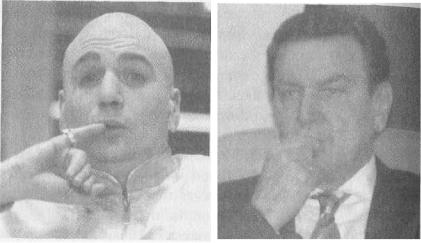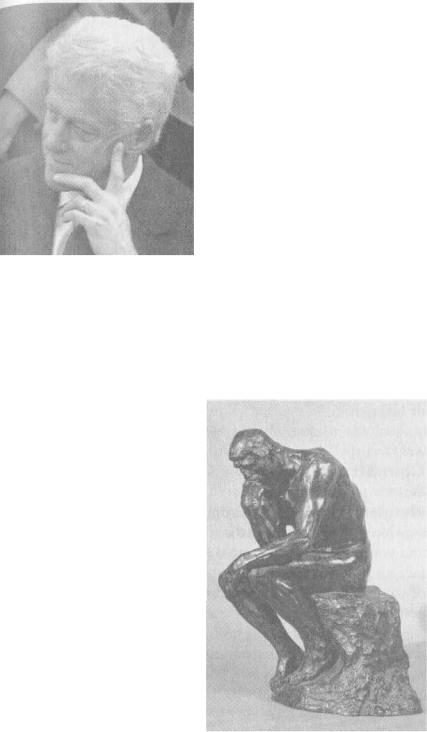
Books on Happiness / The Definitive Book Of Body Language- 2 students
.pdf
Evaluation and Deceit Signals
6.The Neck Scratch
The index finger — usually of the writing hand — scratches the side of the neck below the earlobe. Our observations of this gesture reveal the person scratches an average of five times. Rarely is the number of scratches less than five and hardly ever more than five. This gesture is
a signal of doubt or uncertainty and is characteristic of the person who says, 'I'm not sure I agree.' It is very noticeable when the verbal language contradicts it, for example, when the person says something like, 'I can understand how you feel' but the Neck Scratch indicates they don't.
7.The Collar Pull
Desmond Morris was one of the first to discover that lies cause a tingling sensation in the delicate facial and neck tissues, and a rub or scratch was required to satisfy it. This not only accounts for why people who are uncertain will scratch their neck, it presents a good explanation as to why some people use the Collar Pull when
they lie and suspect they have been caught out. Increased blood pressure from the deceit causes sweat to form on the neck when the deceiver feels that you suspect he's not telling the truth.
It also occurs when a person is feeling angry or frustrated and needs to pull the collar away from his neck in an attempt to let the cool air circulate. When you see someone use this gesture, ask, 'Could you repeat that, please?' or, 'Could you clarify that point, please?' This can cause the would-be deceiver to give the game away.
153

The Definitive Book of Body Language
8. Fingers-in-the-Mouth
This is an unconscious attempt by the person to revert to the security of the child sucking on his mother's breast and occurs when a person feels under pressure. A young child substitutes his thumb or a blanket for his mother's breast and, as an adult he puts his fingers to his mouth and sucks on cigarettes, pipes' pens and glasses, and chews gum.
Reassurance is needed here
Most Hand-to-Mouth gestures can be connected to lying or deception but the Fingers-in-Mouth gesture is an outward indication of an inner need for reassurance so giving the person guarantees and assurances is a positive move.
Evaluation and Procrastination Gestures
A good speaker is said to be one who 'instinctively' knows when his audience is interested in what he's saying and can also tell when his listeners have had enough. A good salesperson senses when he is hitting his client's 'hot buttons' and finding out where the buyer's interest lies. Every presenter knows the empty feeling that results when he or she is giving a presentation to someone who says very little and just sits there
154

Evaluation and Deceit Signals
watching. Fortunately, there are a number of Hand-to-Cheek andHand-to-Chin gestures that can be used as a thermometer to test how hot or cold the other person's attitude is, and to tell the speaker how well he is doing.
Boredom
When the listener begins to use his hand to support his head, it is a signal that boredom has set in and his supporting hand is an attempt to hold his head up to stop himself from falling asleep. The degree of the listener's boredom is related to the extent to which his arm and hand are supporting his head. It usually begins with the chin being supported by the thumb and then by the fist as interest wanes. Extreme lack of interest is shown when the head is fully supported by the hand (see illustration), and the ultimate boredom signal occurs when the head is fully supported by the hands and snoring sounds are evident.
The hand supporting the head to stop from falling asleep
Drumming the fingers on the table and continual tapping of the feet on the floor are often misinterpreted by professional speakers as boredom signals, but in fact signal impatience. If you are addressing a group of people and see these signals, a strategic move must be made to get the finger drummer or foot tapper involved in the conversation to avoid his negative effect on the other listeners. Any audience that displays boredom and impatience signals together is telling the speaker that it is time for him to end.
155

The Definitive Book of Body Language
'Do you talk in your sleep?' he asked the speaker. 'No,'came the reply.'Then please don't talk in mine.'
The speed of the finger or foot tap is related to the extent of the person's impatience — the faster the taps, the more impatient the listener is becoming.
Evaluation Gestures
Evaluation is shown by a closed hand resting on the chin or cheek, often with the index finger pointing upwards. When the person begins to lose interest but still wants to appear interested for courtesy's sake, the position will alter so that the heel of the palm supports the head as boredom sets in.
Interestedevaluation—
the head supports itself and the hand rests on the cheek
Middle managers often use this gesture to feign interest to the company president who is giving a dull, boring speech. Unfortunately for them, however, as soon as the hand begins to support the head in any way, it gives the game away and the president is likely to feel that some of the managers are being insincere or using false flattery.
Having negative thoughts
56

Evaluation and Deceit Signals
Genuine interest is shown when the hand lightly rests on the cheek and is not used as a head support. When the index finger points vertically up the cheek and the thumb supports the chin, the listener is having negative or critical thoughts about the speaker or his subject. Sometimes the index finger may rub or pull at the eye as the negative thoughts continue.
This gesture is often mistaken as a signal of interest, but the supporting thumb
under the chin tells the truth about the critical attitude. Holding a gesture cluster affects a person's attitude so the longer a person holds it, the longer their critical attitude will remain. This gesture cluster
is a signal that immediate action is required by the speaker, either by involving the listener in what he is saying or by ending the encounter. A simple move, such as handing something to the listener to alter his Pose, can cause a change in attitude.
Rodin's The Thinker showed a thoughtful, evaluative attitude, but the body posture and hand supporting the head also reveal a dejected person
157
The Definitive Book of Body Language
The Lying Interviewee
We interviewed a man who had arrived from abroad to apply for a position with our company. Throughout the interview he kept his arms and legs crossed, used critical evaluation clusters, had very little palm use and he looked away frequently. Something was obviously worrying him, but in the early stages of the interview we didn't have sufficient information for an accurate assessment of his negative gestures. We asked questions about his previous employers in his native country. His answers included a series of eyerubbing and nose-touching gestures and he continued to look away. We eventually decided not to hire him, based on what we had seen as opposed to what he had said. We were curious about his deceit gestures and when we checked with his overseas referees, we discovered that he had given false information about his past. He assumed that a potential employer in another country probably wouldn't bother to check overseas references and, had we not been aware of the body language cues and signals, we could have made the mistake of hiring him.
Chin Stroking
The next time you have the opportunity to present an idea to a group of people, watch them carefully as you give your idea and you may notice that most will bring one hand up to their face and use an evaluation gesture. When you come to the end of your presentation and ask the group to give opinions or suggestions about your ideas, the evaluation gestures will usually stop and a Chin Stroking gesture begins. This Chin Stroke is the signal that the listener is going through the decisionmaking process.
58

Evaluation and Deceit Signals
Making a decision |
Female version of Chin Stroking |
When you've asked the listeners for their decision and they start Chin Stroking, their next gestures will signal whether their decision is negative or positive. Your best strategy is to stay quiet and watch their next gestures, which will indicate the decision reached. For example, if the Chin Stroke is followed by crossed arms and legs and the person sits back in their chair, it's a fair bet the answer will be 'no'. This gives you an early opportunity to resell the benefits before the other person verbalises 'no' and makes it harder to reach agreement.
If the Chin Stroke is followed by leaning forward with arms open or picking up your proposal or sample, chances are you have a 'yes' and can proceed as if you have agreement.
Stalling Clusters
Someone who wears glasses sometimes follows an evaluation cluster by taking off their glasses and putting one arm of the frame in the mouth instead of using the Chin Stroke when making their decision. A cigarette smoker will take a puff of smoke.When a person puts a pen or a finger in their mouth after
159

The Definitive Book of Body Language
you've asked for a decision, it's a signal that he is unsure and reassurance is needed. The object in the mouth allows him to stall and not feel any urgency in giving an immediate response.
Sometimes boredom, evaluation and decision-making gestures come in combinations, each showing different elements of the person's attitude.
The next illustration shows the evaluation gesture moved to the chin, and the hand may also be stroking the chin. This person is evaluating the proposition and drawing conclusions simultaneously.
Evaluation/decision-making cluster
When the listener begins to lose interest in the speaker, the head begins to rest on the hand. The next picture shows evaluation with the head supported by the thumb as the listener becomes uninterested.
Evaluation, decision, boredom cluster
160

Evaluation and Deceit Signals
Arnold Schwarzenegger drives home his point while the TV host thinks it over
Head Rubbing and Slapping Gestures
When you say someone 'gives you a pain in the neck', you are referring to the ancient reaction of the tiny erector pillae muscles on the neck — often called goosebumps — attempting to make your non-existent fur pelt stand on end to make yourself appear more intimidating because you are feeling threatened or angry. It's the same hairraising reaction an angry dog has when it's confronted by another potentially hostile dog. This reaction causes the tingling feeling you experience on the back of your neck when you feel frustrated or fearful. You'll usually rub your hand over the area to
'Pain in the neck' gesture |
satisfy the sensation. |
16

The Definitive Book of Body Language
Let us assume, for example, that you asked someone to do a small favour for you and that they had forgotten to do it When you ask them for the result, they slap either their forehead or back of the neck, as if they were symbolically beating themselves. Although slapping of the head is used to communicate forgetfulness, it's important to watch whether they slap the forehead or neck. If they slap their forehead, they signal that they are not intimidated by you mentioning their forgetfulness. When they slap the back of the neck to satisfy the raised erector pillae muscles, however, it tells you that you are literally a 'pain-in-the-neck' for mentioning it. If the person slaps their rear end however...
Gerard Nierenberg, of the Negotiation Institute in New York, found that those who habitually rub the back of the neck have a tendency to be negative or critical, whereas those who habitually rub their foreheads to non-verbalise an error tend to be more open and easy-going.
Punishing oneself by slapping oneself
Acquiring the ability to interpret hand-to-face gestures accurately in a given set of circumstances takes time and observation. When a person uses any of the hand-to-face gestures discussed in this chapter, it's reasonable to assume a negative thought has entered his mind. The question is, however, what is the negative thought? It could be doubt, deceit, uncertainty, exaggeration, apprehension or outright lying. The real skill is the ability to interpret which negative is the correct one. This can best be done by an analysis of the gestures preceding the hand-to-face gesture and interpreting it in context.
162
